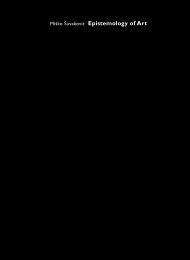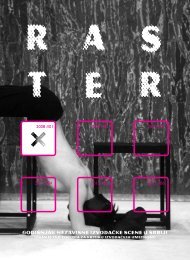Yearbook of the Independent Performing Arts Scene in Serbia - TkH
Yearbook of the Independent Performing Arts Scene in Serbia - TkH
Yearbook of the Independent Performing Arts Scene in Serbia - TkH
Create successful ePaper yourself
Turn your PDF publications into a flip-book with our unique Google optimized e-Paper software.
powerful <strong>in</strong>stitutional resources, achieved significant media attention andentered <strong>of</strong>ficial systems <strong>of</strong> representation and documentation. Works andprojects presented here were selected precisely because <strong>the</strong>y do not fallunder <strong>the</strong> auspices <strong>of</strong> any <strong>of</strong> <strong>the</strong> numerous public cultural <strong>in</strong>stitutions designatedto record, archive and promote such <strong>in</strong>herently ephemeral artisticforms as <strong>the</strong>atre, performance or dance – leav<strong>in</strong>g beh<strong>in</strong>d for <strong>the</strong> purposes<strong>of</strong> history only documents and records. It is important to note that <strong>the</strong> <strong>in</strong>dependent,‘o<strong>the</strong>r scene’ (and most <strong>of</strong> <strong>the</strong> groups and authors represented<strong>in</strong> this publication are part <strong>of</strong> <strong>the</strong> O<strong>the</strong>r scene [Druga scena]), should notbe regarded as a refuge to those (for any reason) lack<strong>in</strong>g access to public<strong>in</strong>stitutions but – on <strong>the</strong> contrary – as a conscious ideological-artistic act,demarcat<strong>in</strong>g a new cultural realm <strong>in</strong> <strong>the</strong> local context. 8This be<strong>in</strong>g <strong>the</strong> first <strong>in</strong>, hopefully, long series <strong>of</strong> yearbooks, <strong>the</strong> <strong>in</strong>troductoryessays aspire, <strong>in</strong> cover<strong>in</strong>g different time frames, at detailed mapp<strong>in</strong>g <strong>of</strong> <strong>the</strong>contexts br<strong>in</strong>g<strong>in</strong>g about <strong>the</strong>se productions. Milena Bogavac’s text thus addresses<strong>the</strong> notion <strong>of</strong> <strong>Serbia</strong>n alternative <strong>the</strong>atre <strong>in</strong> <strong>the</strong> 2000s, <strong>in</strong> establish<strong>in</strong>gproductive, ethical and aes<strong>the</strong>tical, differences between <strong>the</strong> <strong>in</strong>dependentand state-sponsored cultural assets. In her contribution, Ana Vilenicaprovides a condensed historic overview <strong>of</strong> performance art <strong>in</strong> <strong>Serbia</strong> <strong>in</strong> <strong>the</strong>last four decades, proceed<strong>in</strong>g with a detailed contextual map <strong>of</strong> actions/performances produced here throughout <strong>the</strong> last year. Ana Vujanović exam<strong>in</strong>esand reconstructs <strong>the</strong> never-before-written local history <strong>of</strong> <strong>the</strong> XXcentury dance. Address<strong>in</strong>g dance as a social symptom, she engages withproblems <strong>of</strong> broad paradigm shifts from Socialism, via post-Socialism, to <strong>the</strong>neo-liberal capitalism, occurr<strong>in</strong>g <strong>in</strong> <strong>Serbia</strong> and <strong>the</strong> region with <strong>the</strong> demise<strong>of</strong> <strong>the</strong> Socialist Federative Republic <strong>of</strong> Yugoslavia (and concurrently with<strong>the</strong> emerg<strong>in</strong>g wave <strong>of</strong> <strong>in</strong>dependent <strong>the</strong>atre groups <strong>in</strong> <strong>the</strong> early 90s). As ma<strong>in</strong>problems <strong>of</strong> <strong>the</strong> contemporary dance scene <strong>in</strong> <strong>Serbia</strong> (which applies to <strong>the</strong>overall <strong>in</strong>dependent artistic scene, even <strong>the</strong> <strong>in</strong>stitutional one), among o<strong>the</strong>rth<strong>in</strong>gs, Vujanović specifies slow advance and lack <strong>of</strong> critical-<strong>the</strong>oreticalreflection.S<strong>in</strong>ce its launch <strong>in</strong> 2001 <strong>TkH</strong> Journal for <strong>Perform<strong>in</strong>g</strong> <strong>Arts</strong> Theory has regularly(<strong>in</strong> issues 2, 3, 6 and 9 9 ) published features dedicated to critique <strong>of</strong> contemporaryartistic practices. Featured critical reviews were not solely aboutdiscuss<strong>in</strong>g and promot<strong>in</strong>g particular productions, but demonstrated differentways <strong>of</strong> writ<strong>in</strong>g on perform<strong>in</strong>g arts – form<strong>in</strong>g a solid ground for <strong>in</strong>ven-8 More <strong>in</strong> Milena Bogavac’s text “EX Theatre <strong>in</strong> <strong>Serbia</strong> – alternative has noalternative!”, pages 13-20 <strong>of</strong> this publication.9 Issues <strong>of</strong> <strong>the</strong> magaz<strong>in</strong>e available at: www.tkh-generator.net/sr/casopis.







